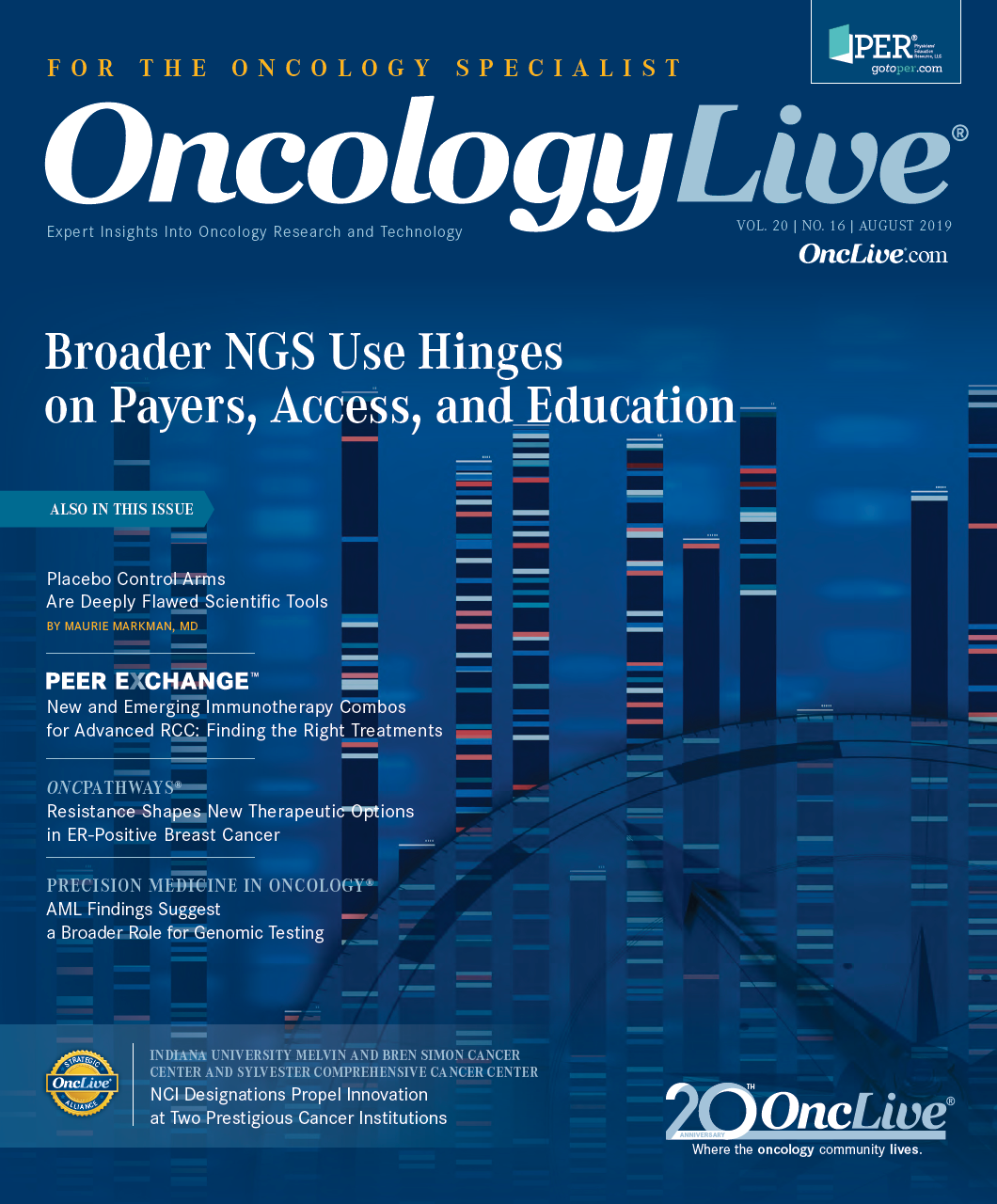Investigators Assess PARP Inhibitor-Abiraterone Combo as Frontline mCRPC Therapy
Seeking to explore an apparent synergy between agents, investigators are evaluating the PARP inhibitor olaparib in combination with the hormone blocker abiraterone in men with metastatic castration-resistant prostate cancer who have received no prior cytotoxic chemotherapy or new hormonal agents.
Andrew J. Armstrong, MD

Andrew J. Armstrong, MD
Seeking to explore an apparent synergy between agents, investigators are evaluating the PARP inhibitor olaparib (Lynparza) in combination with the hormone blocker abiraterone (Zytiga) in men with metastatic castration-resistant prostate cancer (mCRPC) who have received no prior cytotoxic chemotherapy or new hormonal agents. The multicenter phase III PROpel study (NCT03732820) will enroll approximately 720 patients globally and randomize them to receive olaparib with abiraterone or placebo plus abiraterone.
PROpel’s primary endpoint is radiologic progression-free survival (rPFS) (Figure).1 Secondary endpoints include time to first subsequent anticancer therapy or death, time to pain progression, and overall survival.
The rationale for the study is based on findings from a phase II study (NCT01972217) that broadly examined olaparib in combination with abiraterone in patients with mCRPC who had previously received docetaxel and were candidates for abiraterone treatment.1 Although patients with mCRPC and homologous recombination repair (HRR) mutations are known to have a better response to olaparib than patients without mutations, investigators assessed the efficacy of the doublet in those with mCRPC regardless of mutation status.2
In the phase II study, the investigators found that olaparib plus abiraterone significantly prolonged rPFS compared with abiraterone alone. The median rPFS was 13.8 versus 8.2 months (HR, 0.65; 95% CI, 0.44- 0.97; P = .034). However, treatment with the combination led to more adverse events (AEs): Of 71 patients in each arm, 66 (93%) who received the doublet regimen experienced an AE compared with 57 (80%) of those treated with abiraterone only.
The phase II study was the first trial with results that showed clinical benefit for patients with mCRPC who had previously received docetaxel, according to investigators. Further, data from the study suggested that the clinical benefit that olaparib and abiraterone elicited occurred regardless of HRR mutation status.
“The interesting result was that the rPFS improved in these patients irrespective of whether a patient had a homologous repair deficiency,” said Andrew J. Armstrong, MD, ScM, director of research at Duke Cancer Institute Center for Prostate and Urologic Cancers and a faculty member in the Department of Medicine, Duke University School of Medicine, Durham, North Carolina. “The patients who did have testing and who were negative for mutations still had an improved outcome with the combination, and that was the biggest surprise,” he added.
PROpel is the follow-on study to this phase II trial.1 It is also the first phase III study to evaluate a PARP inhibitor in combination with abiraterone as a first-line treatment in a genetically unselected population of patients with mCRPC.
In the second-line setting, olaparib demonstrated a statistically significant improvement in rPFS versus enzalutamide (Xtandi) or abiraterone in men with mCRPC with BRCA1/2 or ATM gene mutations in the phase III PROfound trial, according to AstraZeneca and Merck, the companies jointly developing olaparib.3
Figure. Olaparib Plus Abiraterone as Frontline mCRPC Therapy1
The study sought to recruit 340 patients with mCRPC who progressed on prior therapy with a new hormonal agent and harbored a mutation in 1 of 15 HRR pathway genes. The primary endpoint was rPFS in participants with BRCA1/2 or ATM mutations. Full data are expected to be presented at an umpcoming medical meeting.
Hypothesizing Synergy
DNA repair alterations are prevalent in mCRPC: An estimated one-fifth or more of patients with mCRPC harbor defects in genes involved in DNA repair, such as BRCA1 and BRCA2.4 “Recent data from the past 5 years show that 20% of men with metastatic prostate cancer will have genomic alterations in DNA repair genes such as BRCA2,” Armstrong said. “It’s known that when a patient has a germline or somatic homologous repair mutation, such as BRCA2, [this alteration] confers sensitivity to DNA-damaging agents, such as PARP inhibitors and platinum chemotherapy.”
Treatment with a PARP inhibitor can prompt a synthetic lethal interaction that engenders the death of cancer cells in patients with HRR mutations. PARP inhibitors, such as olaparib, interfere with the repair of single- and double-stranded breaks in DNA, thereby promoting cell death, explained Celestia S. Higano, MD, in an interview with OncologyLive®.
PROpel investigators hypothesize that olaparib’s mechanism of action complements abiraterone’s inhibition of the enzyme CYP17A1, which is highly expressed in testicular, adrenal, and prostatic tumor tissue and catalyzes the biosynthesis of androgen hormones.
“There have been several manuscripts documenting the importance of the androgen receptor [AR] in regulating DNA repair enzyme activity, and when you block the androgen receptor with hormonal therapies, it impairs DNA repair. The AR regulates DNA repair, and when you block it, there’s less DNA repair,” Armstrong said. “You’re basically inducing a homologous repair defect in the tumor by using abiraterone, and then you’re taking advantage of that DNA repair defect and giving a DNA repair inhibitor, olaparib.”
Broadening Benefit
Although the PROpel study will explore the joint activity of olaparib and abiraterone in a genetically unselected population of treatment-naïve men with mCRPC, investigators will nevertheless look at the genetics of the enrollees to determine whether subgroups of patients will derive a greater or lesser benefit from the doublet, according to Armstrong.
“The hope of combining hormonal therapy with olaparib is that there will be some synergy and there won’t be as much of a need to screen every patient for BRCA1 and BRCA2 mutations [to determine] eligibility for a PARP inhibitor. So this could expand the number of patients who may benefit,” he said.
PROpel investigators will closely monitor the study’s population for AEs, due to the elevated toxicity of the doublet. “In the initial phase II trial post docetaxel, increased toxicity was seen, particularly cardiovascular toxicity [anemia], so there’s been particular attention [paid to] selecting patients at low risk for cardiovascular events,” Armstrong said.
In the phase II study that gave rise to PROpel, 15 (21%) of 71 patients treated with olaparib and abiraterone experienced grade 3 anemia compared with 0 patients who received abiraterone only. Investigators said serious AEs occurred in 24 (34%) patients receiving olaparib and abiraterone (7 related to treatment) and in 13 (18%) patients receiving placebo and abiraterone (1 related to treatment). There was 1 treatment-related death (pneumonitis) in the combination group.2
“The biggest adverse effect of olaparib is anemia, which can cause a strain on the heart in this elderly male population, so there will be attention to the management, treatment, and prevention of that,” Armstrong said. “With abiraterone, the biggest adverse effect is high blood pressure due to mineralocorticoid excess, and that can also put a strain on the heart, so very [diligent] blood pressure control and management, [including] screening, should reduce the risks of cardiovascular events over time,” he added.
To justify the added toxicity of the combination, investigators will need to see a significant delay in disease progression and acceptable toxicity, according to Armstrong.
“Currently, if you’re a patient with mCRPC, you’re being treated with first-line abiraterone or enzalutamide, and the median PFS [progression-free survival] is about 16 to 18 months, so there is a great unmet need [in this population],” Armstrong said. “It sounds like a long time compared with what it used to be for docetaxel, which was about 7 to 8 months, and for older, first-generation hormonal therapies, it was about 6 months. So 16 to 18 months is a long time compared with what we used to have, but a short time in the lifespan of a patient,” he added. “There’s still a major unmet need for [agents] that further delay progression, but in a safe manner.”
PROpel, which began in October 2018, continues to enroll patients across more than 100 global sites.
References
- Clarke NW, Armstrong AJ, Thiery-Vuillemin A, et al. PROPEL: a randomized, phase III trial evaluating the efficacy and safety of olaparib combined with abiraterone as first-line therapy inpatients with metastatic castration-resistant prostate cancer (mCRPC). J Clin Oncol. 2019;(37)(7_suppl):TPS340. doi: 10.1200/JCO.2019.37.7_suppl.TPS340.
- Clarke N, Wiechno P, Alekseev B, et al. Olaparib combined with abiraterone in patients with metastatic castration-resistant prostate cancer: a randomised, double-blind, placebo-controlled, phase 2 trial. Lancet Oncol. 2018;19(7):975-986. doi: 10.1016/S1470-2045(18)30365-6.
- Lynparza phase III PROfound trial in HRR* mutation-selected metastatic castration-resistant prostate cancer met primary endpoint [press release]. Kenilworth, NJ: AstraZeneca and MSD Inc.; August 7, 2019. www.astrazeneca.com/media-centre/press-releases/2019/lynparza-phase-iii-profound-trial-in-hrr-mutation-selected-metastatic-castration-resistant-prostate-cancer-met-primary-endpoint-07082019.html. Accessed August 12, 2019.
- Cheng HH. The resounding effect of DNA repair deficiency in prostate cancer. Urol Oncol. 2018;36(8):385-388. doi: 10.1016/j.urolonc.2018.02.014.




